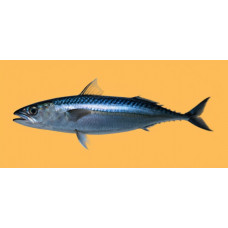Latin name
Scomber australasicus
Other name
Japanese mackerel, Pacific mackerel, slimy mackerel or spotted chub mackerel.
Identification
The blue mackerel has an elongated, spindle-shaped body with a thin, laterally compressed caudal peduncle with 2 lateral carinae, the longitudinal middle carina between them being absent. The body is completely covered with fine cycloid scales. There is a swim bladder. The anterior shell of large scales is absent. The lateral line is almost straight, with a slight wavy curve. The teeth are small, conical and in one row. The number of vertebrae is 31. Canines are present.
Features of fish fins
Fish of this species have a row of 5 additional fins behind the soft dorsal and anal fins. The first dorsal fin has 10-13 barb rays, the second dorsal fin has 12 soft rays and the anal fin has 12 soft rays. In front of the anal fin there is 1 barb that is separated from the fin. The pelvic fin is low and not forked. Caudal fin is hard and broadly forked. The anal fin begins behind the second dorsal fin.
Fish colouring
The back is dark blue or greenish-blue with wavy dark cross-lines. The flanks and belly are silvery white or with bluish-grey spots and wavy broken lines.
Distribution
Blue mackerel are found in the coastal waters of the western Pacific Ocean from China and Japan to Australia and New Zealand, and east to Hawaii. They are also found in the Red Sea. It is quite rare in tropical waters.
Habitat
These are meso- and epipelagic fish found in coastal waters from the surface to depths of 300 metres.
Size
The maximum length of individuals of this species to the fork of the caudal fin is 50 cm. The maximum recorded weight is 1.4 kg.
Behavior
A pelagic social fish found mainly in coastal waters. It is an important link in the trophic chain, preying on large pelagic fish such as sharks, tuna, swordfish and marine mammals such as dolphins and sea lions. Forms schools with other mackerels of similar size.
Food and feeding habits
Zooplankton forms the basis of the fish's diet. Adults also feed on small fish and squid.
Reproduction
In Australian waters, this species is sexually mature at about 2 years of age. Life expectancy is estimated to be 8 years. Generation time is 2-3 years. According to estimates by various authors, Australian mackerel in New Zealand waters mature at three years with a body length of 28 cm and a life expectancy of 24 years. In Japanese waters, the species matures at the age of one year and lives up to 6 years.
Fishing
A valuable commercial fish. It is mainly fished using multi-deep trawls, purse seines and ring seines. In Japan, the meat of blue mackerel is less valued than that of Japanese mackerel.
Relationship with a person
Harmless. It is marketed in frozen, smoked, canned and salted forms.
| Classification | |
| Phylum | Chordata |
| Class | Actinopterygii |
| Squad | Scombriformes |
| Family | Scombridae |
| Genus | Scomber |
| Species | S. australasicus |
| Features | |
| Conservation status | Least Concern |
| Habitat | Pelagic |
| Life span, years | 8 |
| Maximum body weight, kg | 1,4 |
| Maximum length, cm | 50 |
| Sailing speed, m/s | No information |
| Threat to people | Edible |
| Way of eating | Planktonophage |
Blue mackerel
Tags: blue mackerel

